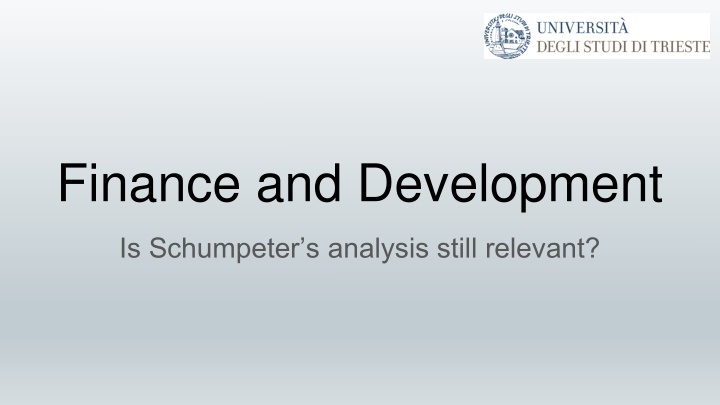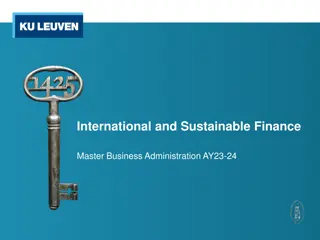
Analysis of Schumpeter's Relevance in Financial Development Studies
Explore the relevance of Schumpeter's analysis in financial development through Rajan and Zingales' evaluation. The paper delves into the necessity of a well-developed financial system for economic growth, focusing on the link between financial structure and innovation as key drivers. Understand the significance of financial intermediaries in resource allocation and innovation within the financial sector.
Download Presentation

Please find below an Image/Link to download the presentation.
The content on the website is provided AS IS for your information and personal use only. It may not be sold, licensed, or shared on other websites without obtaining consent from the author. If you encounter any issues during the download, it is possible that the publisher has removed the file from their server.
You are allowed to download the files provided on this website for personal or commercial use, subject to the condition that they are used lawfully. All files are the property of their respective owners.
The content on the website is provided AS IS for your information and personal use only. It may not be sold, licensed, or shared on other websites without obtaining consent from the author.
E N D
Presentation Transcript
Finance and Development Is Schumpeter s analysis still relevant?
1.1 Rajan and Zingales use important elements of Schumpeter s theoretical framework meanwhile re-evaluate the importance of Schumpeter s contribution the paper is divided in two parts 1. analysis of RZ 2. elements of Schumpeter s theory that they overlook
Part One: Rajan and Zingales analysis 2.1 Thesis: The presence of a well-developed financial system is a necessary condition for the achievement of high economic growth rates A) Theory to explain the link between financial structure and economic development B) Definition and measurement of financial structure s development i.e. distinction between developed and undeveloped financial structure using the concept of innovation underlined by the Schumpeter s analysis i.e. innovation is based upon a change
A) Link: financial structure and economic development Approach: financial structure is significant if we abandoned the hypothesis of perfect market markets are characterized by imperfect information which impede their functioning generally, in financial markets a given amount of money is exchanged between debtor and creditor for the promise of receiving a greater amount of money in the future the difficulties the creditors encounters in obtaining relevant information may make the exchange impossible
A) Link: financial structure and economic development the level of development of a financial structure is measured in relation to its capacity to produce service that reduce the effects of imperfect information and diminish the transaction costs the financial sector is therefore important because the financial intermediaries are responsible for and may influence resource allocation main tool for innovation
B) Development: determined by two endogenous factors 1.system of production that comprises the innovation introduced by entrepreneur (realisation of new product, new production method, opening of new markets) 2.creation of money by banks through credit RZ - the level of development of a financial structure can be measured in relation to the capacity to finance innovation the right measure for financial development would capture the ease with which any entrepreneur or company with a project can obtain finance and the confidence with which investors anticipate an adequate return
2.2 Two necessary condition to develop a financial system B) The presence of institution that make it possible to take the risk of financing innovations A) Respect & Safeguard a legal system to enforce property rights; - limited liability stock company facilitate private contracting and protects legal rights - capable to overcome the problem of adverse selection and moral hazard (caused by the imperfect information)
Two configurations of the financial system Relation- based System: Arm s-length System close relation bank borrowing firm potential no kind of relationship It is a developed financial system with institutions that guarantee PR and that make it possible to take risk associated with financing innovation Banks at the center of this system not able to take the risk of financing innovation Multiplication of number of financiers
Example: Fusty House (= Relationship finance) Chancy House (= Arm s length system) -joint decision -independent decision -publish few books of known authors -publish many books of new authors -better in times of gradual changes - better in period of great changes = the public is ready to new literary style
2.3 Banks and Asymmetric Information A)asymmetric information approach (Stiglitz, Blinder, Fama, Levine, ) need of *financial intermediaries to reduce costs associated to asymmetric information presence of banks is justified by the imperfection in info - savers cannot directly finance firms *financial intermediaries = specialize in gathering information and in evaluating the quality of good exchanged between creditor and debtor if operators have the same info same evaluations and same decision
2.3 Banks and Asymmetric Information B) world of uncertainty Rajan and Zingales: if operators have same info due to uncertainty on future outcome the probability that an innovation would be financed raises as the number of potential financiers increases Banks tend to protect interests of established firms with whom they have a consolidated relation (relation-system) and to exclude from financing the new entrepreneur who intend to introduce innovation
Part two: elements of Schumpeters theory that they overlook COMMON POINT Schumpeter - Innovations are not mainly introduced by existing firms, but rather they are made by new economic agents RZ - highlight this view stating that young firms are special when there is a potential for extraordinary change because they have no interest in the current status BUT Schumpeter Rajan and Zingales Banks as essential elements for innovation Banks as obtacle of innovation Not finance new firms innovation carry out by new firm with no means of production and capital
Part two: elements of Schumpeters theory that they overlook How to evaluate quality of innovation Rajan and Zingales Schumpeter Quality of innovation is defined in relation to its capacity to satisfy the consumers needs Quality of innovation given by the decision of the entrepreneur / innovator bank and the In an ideal world, a developed financial system allows the use of resources to carry out innovation to better satisfy consumer demands Consumers choices are conditioned by the decisions of the entrepreneur and the banks
THANK YOU FOR YOUR ATTENTION ELEONORA CIA and ROBERTA ROPPO






















